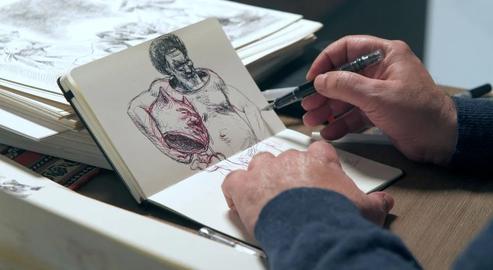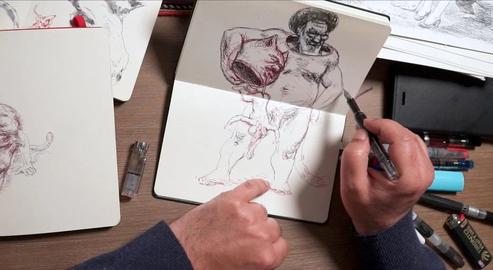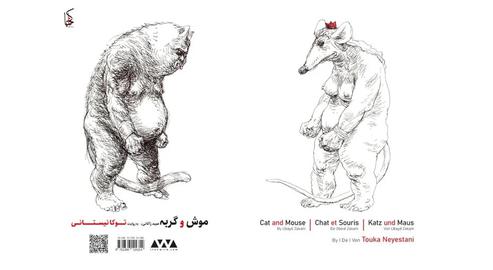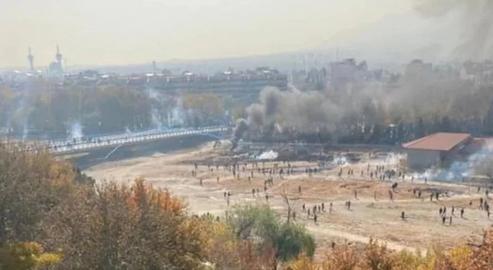Below is the full transcript of is an interview between Maziar Bahari and legendary cartoonist in exile Touka Neyestani, mark the publication of his new graphic novel, Cat and Mouse. To learn more about the new book watch our short documentary, or to get a copy of your own, click here.
One of the pleasures of my job as editor of IranWire is receiving Touka Neyestani’s cartoons at the end of the day together with a very short note: “There you go”, and the title of the cartoon. My first reaction is that of shock, then a smile. Finally, I come to appreciate his drawing techniques: how he captures a given event so brilliantly using the complex blend of hatching and cross-hatching that has become his trademark.
Touka’s cartoons capture the violent absurdity of the mullahs and revolutionary guards at the helm of the Islamic Republic of Iran. He cuts through the protagonists’ ideological and revolutionary rhetoric and displays the true nature of the regime underneath. The cartoons are borderline cruel; they depict vicious human beings who’ll do anything to stay in power. Public executions, women forced to give birth, child marriages, the shooting down of a passenger plane and Iran’s nuclear program have been among the subjects of Touka’s recent work.
Touka’s editorial cartoons regularly shock and delight IranWire readers. So we thought it would be interesting to work with him on a book. He chose Ubayd Zakani’s The Mice and the Cat. The book is a classic and has been part of Iran’s popular culture for generations. Different Iranians have their own interpretations of the saga, and discussions abound on its meaning: Who did Obeid have in mind when he wrote the poem? What is the point of this surreal story? Are we among the cats, or the mice?
To find out more about this particular series of cartoons as well as his own life and career, I visited Touka at his house in a Toronto, Canada, where he’s been living for the past 12 years.
-
So, how did you come up with the idea of a Cat and Mouse book?
I took my sketchbook to a café and ordered a coffee. As I was sipping it, I began to draw the first cat, and then the first mouse that came to my mind. Since I love figurative drawing, I didn’t want my cats to resemble cats too much. Never in my life have I had a cat for long. The only cats I’d seen were the ones in the street. As I was drawing, they became more like people: my cats started to resemble men, and my mice looked like women. Of course, it wasn’t intentional, and I didn’t turn the story into a war between the sexes. I drew both male and female mice in the mouse army. But in general, my mice became female, and my cats became male. Sometimes they followed the story, and sometimes they’d leave it and live outside the narrative. Many times, as I was drawing, I abandoned the story along with them and followed their mischief instead.
One thing is very clear in your sketches: your cat is very proud of his masculinity. I mean, his masculinity is very pronounced. I’ll be clear: his sexual organ draws the eye.
Really? I didn’t notice this before. Let me see. Perhaps.
You must have noticed. In one place it’s licking itself.
Yes, when a cat licks itself, something anatomically strange happens. Strange because the cat maneuver all over its body. It can reach every part of its body with ease. When my cat turned into a man-cat, the man had to turn back into a cat too. How can a man lick himself as meticulously, as elegantly and as perfectly as a cat? Drawing this was appealing to me. In some places, the cats aren’t even that dissimilar to myself.
In terms of the cat’s personality, or its form?
Its form. In all the work I do, I always like to have some piece, some aspect of myself in the characters I draw. Of course, generally, I perceive my characters negatively. I mostly question myself in my work. Now I like to say that the things I’ve drawn are about me. I put myself in prominent places on the page. And the interpretations put forward by other people aren’t good ones, so I don’t want to look at them in that way.
When you’re working on your cartoons, do you think about whether or not people will like them?
Yes. Naturally, this leads to a sort of self-censorship. One of the reasons I drew the cats with their sexual organs showing is I wanted to escape the self-censorship I’d got used to. The instant you draw something with a tiny bit of nudity, they accuse you of a thousand transgressions. One of my longest-held wishes was to be able to draw nudes.
How much have Iran’s social and political issues influenced your Cat and Mouse illustrations?
A great deal. All the experiences I lived through in Iran, the political violence, the skirmishes, the cat and mouse game, all that bullying, everything... It’s somehow reflected in this work.
But apart from the political and editorial work I do, I spend some of my free time on work that I don’t consider to be editorial, political or regular, everyday stuff. It’s for this reason I have various other works like the Cat and Mouse collection. They’re supplementary; if I were to only do work on socio-political issues it would be exhausting.
Most of your work this collection depicts a war between mice and cats. Is this because of your experience of this harsh atmosphere in Iran? In the poem, there are maybe seven or eight verses about war. But there are many more illustrations of war in your work.
Well, yes. That’s probably it. But another reason is the scenes of conflict create a more interesting opportunity for illustration. Since my childhood, it was those scenes from an earlier book on The Mice and the Cat that were memorable to me. Another part of the story that stays in my head is where the mouse gets drunk at home and says things the cat shouldn’t hear. The war scene had really brilliant, interesting pictures. Unfortunately, I don’t know the name of the illustrator. But after all these years, his work is still vivid and memorable to me.
When were you born? And how old were you at the time of the Islamic Revolution?
I was born in 1960. In 1979, I was eighteen years old. I was in no way a revolutionary. But society was experiencing a revolution. Today’s young people didn’t witness that time, and don’t know what I’m talking about. The truth was that the whole of society had become revolutionary, especially the youth. I was a loner and all I wanted to do was draw and paint. In that environment, certain works like Francisco Goya’s became very popular. I was really influenced by Goya.
Can you remember which of Goya’s works had the most influence on you?
There were two collections of illustrations and prints, called Caprice [Los Caprichos] and The Disasters of War [Los Desastres de la Guerra]. They were both unique, and of excellent quality. One or two films about Goya released at that time were also exceptional. He showed me that you can have a strong voice through drawing. I wasn’t somebody who would take to the streets to protest. But I realized I could protest through my drawings. I loved the majesty of Goya’s scenes, those dark atmospheres. I’m still aspiring to draw like that. I wanted to change something, to have an impact.
What did you want to change?
I wanted to change the world! I wanted to change the government. Then, when I realized I couldn’t change the government, I decided to fight back against stupidity. I figured stupidity was humanity’s biggest problem. If we could convince ourselves to help each other avoid being idiots, our fate might be better. So, I concentrated on fighting stupidity. I targeted that problem. And to avoid offending other people, I drew cartoons featuring myself as the main character. I was trying to say that all stupidity in the world emanates from me. I’m the idiot! So I should change. And if you’re committing stupid acts as well, then stop doing that.
The first time you drew a picture of Iran’s Supreme Leader Ali Khamenei was when I asked you in June 2013 to draw a cartoon on ‘The Last Supper with Khamenei’. Why were you a bit reluctant to draw it?
Until then there was always a way back home. If I went back to Iran I could say something like, well yes, I drew these, but this wasn’t my intention with that particular drawing. Or something like that. With this illustration of Khamenei, I wouldn’t be able to go back.
You’ve been continuing to draw Khamenei, especially since January 2020. I think you’ve drawn Khamenei since then more than you’ve ever drawn him before. Almost all of your cartoons have included Khamenei and a falling plane since then. What does Khamenei symbolize for you now?
I’ve become angrier since the crash – not the ‘crash’, the shooting down – of [Ukrainian Airlines] Flight 752. I feel like my work is angrier than ever.
And you also have a personal reason.
Precisely. My son’s partner was on that plane. I loved her like my own daughter. Right here, where I’m sitting, they’d come once or twice a week for dinner. On this same chair, in this same room, in this same place, I asked her why she was going back to Iran. She said: “I don’t have any vacation leave. I have to go. I haven’t seen my father in five years” – and words to that effect.
She was like a daughter to me. I can’t believe she’s gone, that she’s no longer around. Now that the mourning is over, I’m expecting her to return. How can this happen to somebody who’s alive, who’s healthy? You know, she read so many books. She read a lot, and she worked eight hours a day. She was planning to buy a home. She wanted to buy a home with my son. They wanted to marry this year.
I’m just going crazy. I still get upset when I think about it. It’s really affected my work. I’ve found myself harboring this strange feeling of hatred. I know that in the past 41 years, thousands and thousands of people have had the same devastating experiences. But this feeling is stuck in my heart. And I don’t know why, but I can’t get rid of it. Especially because we haven’t lived in that country for many years; it’s been over ten years since I left Iran. How can they have such a terrible impact even on the lives of people who’ve left the country? This is all because of Mr. Khamenei and his acolytes.
visit the accountability section
In this section of Iran Wire, you can contact the officials and launch your campaign for various problems
























comments